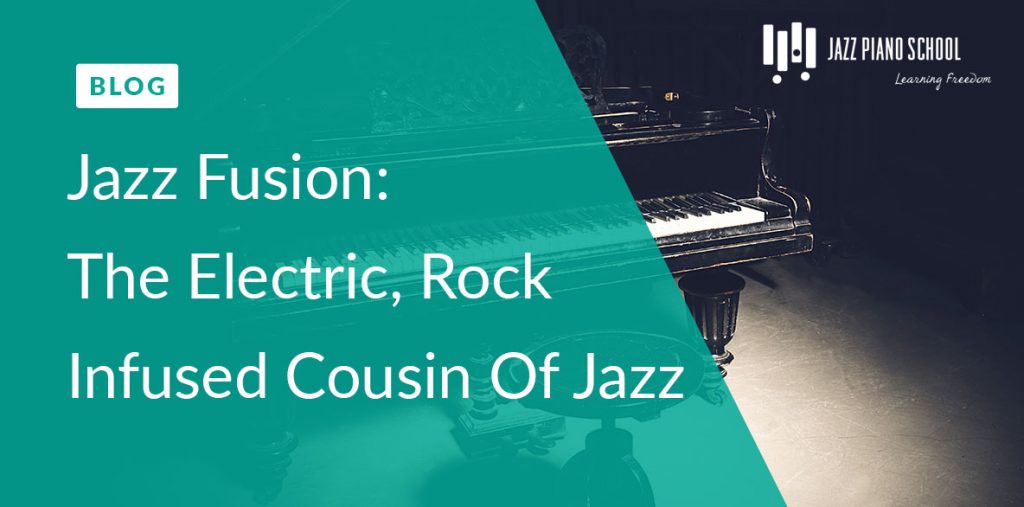
Of course we’re talking about…


As an American art form, jazz has continually evolved to absorb elements of the culture and technology around it. Jazz had progressed from its Dixieland roots in New Orleans into the swing tradition of the 30’s, bebop in the 40’s to hard bop, modal, and cool jazz styles of the 50’s, into post-bop and eventually the avante garde and free jazz of the 60’s. After decades of innovation culminating in the ultra-modern improvised music of the early 60’s, jazz musicians were left wondering what could be next!

Early Beginnings
Around that time, rock music began to get popular and jazz musicians who grew up with its influence started incorporating its elements into their music. Some among the first were guitarist Larry Coryell and vibraphonist Gary Burton.
Other early innovators included saxophonist Charles Lloyd and his quartet which featured a young Keith Jarrett. Here is a great collaboration between Gary Burton and Keith Jarrett during the same time period.
Meanwhile…
Rock musicians started incorporating elements of jazz into their music such as Cream, Jimi Hendrix, and Frank Zappa, who played a particularly important role in this fusion of styles. His album “Hot Rats” was ahead of its time in terms of the cross-pollination which was to occur in the period that followed.
Enter Miles
The ultimate jazz innovator, Miles Davis, made the next move in 1969 with his iconic album “In a Silent Way” which assembled a supergroup including Herbie Hancock, Chick Corea, Joe Zawinul, John Mclaughlin, and Tony Williams. He went on to record what would become the most important album of the jazz-rock movement, “Bitches Brew.” This work incorporated electric instruments with a large emphasis on improvisation in an open setting.
What Followed
This project spawned offshoots by the various alumni from this group in multiple directions:
Herbie Hancock developed his own group called the Headhunters, a funk fusion group which created jazz standards such as “Chameleon.”
Chick Corea took a group in his own direction with more of a rock-centric identity, featuring Stanley Clarke on bass, Al DiMeola on guitar, and Lenny White on drums.
John McLaughlin created another influential group known as the Mahavishnu Orchestra, known for its searing guitar riffs and odd time signatures.
The Essence of Fusion
The innovation which was born out of Miles Davis’ group is evident in the diversity of the groups which followed. The freedom for each of these different projects to take on their own respective identity but still fall within the jazz idiom is remarkable!
One might say that is the beauty of jazz: the freedom within boundaries.
What About Now?
After the initial impetus of the jazz fusion movement in the late 60’s and early 70’s, the door was opened for musicians to stretch the definition of “jazz” to accommodate new cultural elements. Today, we see a new addition of hip hop and neo-soul into this mix.
Robert Glasper has been a significant proponent of this trend, most notably in his group “The Robert Glasper Experiment.”
Further Listening
Herbie Hancock – Mwandishi
https://www.youtube.com/watch?v=lkwluLsP364
George duke
https://www.youtube.com/watch?v=z7EN_oseMso
https://www.youtube.com/watch?v=dk_RfQmV1Zg
Billy cobham
https://www.youtube.com/watch?v=1H4gfJaYqZY
Weather report – black market, birdland
https://www.youtube.com/watch?v=U7_vNpVXubA
https://www.youtube.com/watch?v=Ae0nwSv6cTU
Allan holdsworth
https://www.youtube.com/watch?v=g_TxIBJ7T0M
Tony Williams lifetime
https://www.youtube.com/watch?v=Lm7sDqnPI-w
Robert Glasper Experiment
https://www.youtube.com/watch?v=IcIuGl1_3w8&index=2&list=PLB2AF830C11B1925D
Aaron Parks Invisible Cinema
https://www.youtube.com/watch?v=6565AKRNsHE&list=PLih2S3T8seMpRx4b-mmM6UDPKHVepDEqk&index=2













2 Responses
Thank you for this historical compilation!
FYI the bottom link for Robert Glasper Experiment is a dead link.
Thanks Dina! Will get this fixed!